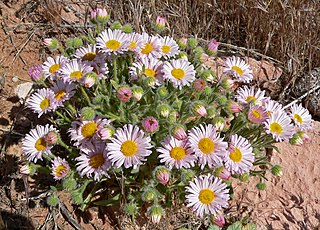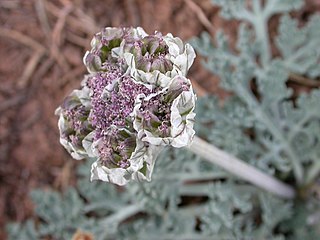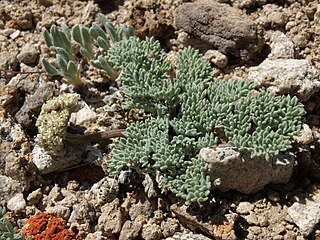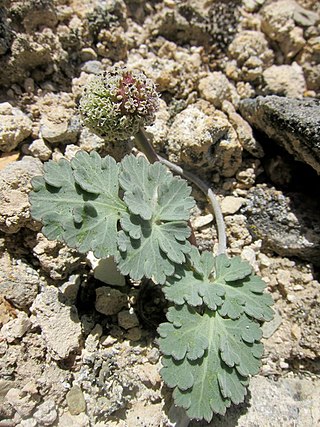
San Juan County is a county in the southeastern portion of the U.S. state of Utah. As of the 2010 United States Census, the population was 14,746. Its county seat is Monticello, while its most populous city is Blanding. The Utah State Legislature named the county for the San Juan River, itself named by Spanish explorers.

The Navajo Nation, also known as Navajoland, is a Native American reservation in the United States. It occupies portions of northeastern Arizona, northwestern New Mexico, and southeastern Utah; at roughly 17,544,500 acres, the Navajo Nation is the largest land area held by a Native American tribe in the U.S., exceeding ten U.S. states. In 2010, the reservation was home to 173,667 out of 332,129 Navajo tribal members; the remaining 158,462 tribal members lived outside the reservation, in urban areas, border towns, and elsewhere in the U.S.. The seat of government is located in Window Rock, Arizona.

Erigeron concinnus, the Navajo fleabane, tidy fleabane or hairy daisy, is a perennial flowering plant in the family Asteraceae.
Cymopterus multinervatus is a species of flowering plant in the carrot family known by the common name purplenerve springparsley. It is a perennial herb native to the southwestern United States, including the desert regions. It is stemless, producing leaves and inflorescence at ground level from a taproot. The leaves are erect on petioles of a few centimeters in length, with a fleshy blade dissected into waxy multilobed leaflets. The inflorescence arises on a stout purple or greenish peduncle up to about 14 centimeters tall. At the top is a rounded cluster of purple flowers sheathed in purple-veined bracts.

Navajo Mountain is a peak in San Juan County, Utah, with its southern flank extending into Coconino County, Arizona, in the United States. It holds an important place in the traditions of three local Native American tribes. The summit is the highest point on the Navajo Nation.

Cymopterus is a genus of perennial plants in the family Apiaceae native to western North America. They are commonly known as the springparsleys. They are mostly stemless, taprooted perennial herbs with leaves at ground level and flowering scapes bearing yellow, white, or purple flowers.

Cymopterus purpurascens is a species of flowering plant in the carrot family known by the common name widewing springparsley. It is native to much of the western United States, including the desert regions. It is a perennial herb, often stemless, producing leaves and inflorescence from ground level or from a fibrous basal stalk. The waxy, fleshy leaves have blades divided into multilobed leaflets and are borne on short petioles. The inflorescence is a rounded cluster of flowers held on a peduncle which may be erect and several centimeters tall or nearly nonexistent. The purple flowers are sheathed in dark-veined white bracts.
Cymopterus aboriginum is a species of flowering plant in the carrot family known by the common name Indian springparsley.

Cymopterus cinerarius is a species of flowering plant in the carrot family known by the common name gray springparsley. This small plant is native to the US states of California and Nevada, where it grows on the rocky talus of the Sierra Nevada. This plant has a short stem and lies against the ground or draped over rocky debris. Its distinctive leaves are only a few centimeters long and dissected into segments of a few millimeters in length. The gray-green segments are thick, pointed lobes with a bumpy textured surface and a waxy epidermal coating. From the center of this patch of leaflets sprouts an erect peduncle holding the flowers. The peduncle and the umbels of flowers are reddish-green or brown and the umbel has very large wrinkly bracts which are more visible than the actual white flower corolla.

Cymopterus gilmanii is a species of flowering plant in the carrot family known by the common name Gilman's springparsley.

Cymopterus globosus is a species of flowering plant in the carrot family known by the common name globe springparsley. This plant is native to the sandy flats extending between eastern California and Utah in the western United States. It is a low, stemless plant with leaves parallel to or lying flat on the ground. The green-gray parsley-shaped leaves are divided into several leaflets, which are further divided into neatly pointed segments. One or more tall purple or red-brown peduncles hold an inflorescence which is a spherical umbel densely packed with white or pinkish-purple flowers. They may be held in pairs atop the peduncle, and are often heavy enough to bend the peduncle to the ground.
Cymopterus ripleyi is a species of flowering plant in the carrot family known by the common name Ripley's springparsley, or Ripley's cymopterus. It is native to Nevada, Arizona and eastern California, where it grows in habitat with sandy soils, such as deserts. It is a stemless perennial herb, producing leaves and inflorescence from the taproot. The shiny, hairless leaves have small, rounded blades with approximately three leaflets each divided into lobes. The leaves are borne on petioles up to 10 centimeters long. The inflorescence is a spherical cluster of purplish or off-white flowers atop a long peduncle.

Carex specuicola is a rare species of sedge known by the common name Navajo sedge. It is native to a small section of the Colorado Plateau in the United States, its distribution straddling the border between Utah and Arizona, and completely within the Navajo Nation. There are several populations but they are limited to a specific type of habitat. The plants grow from the sides of steep, often vertical cliffs of red Navajo Sandstone, in areas where water trickles from the rock. It occurs at elevations between 5,700 and 6,000 feet, usually in shady spots. Though it is not a grass, the sedge grows in inconspicuous clumps resembling tufts of grass sticking out of the rock face. When the sedge was federally listed as a threatened species in 1985, it was known from only three populations in Coconino County, Arizona, with no more than 700 plants existing. The species has since been observed in northeastern Arizona and San Juan County, Utah.
Cymopterus goodrichii is a rare species of flowering plant in the carrot family known by the common name Toiyabe springparsley. It is endemic to Nevada in the United States, where it occurs in the Toiyabe and West Humboldt Ranges.

The Albion Mountains are a mountain range in the U.S. states of Idaho (~99%) and Utah (~1%), spanning Cassia County, Idaho and barely reaching into Box Elder County, Utah. The highest point in the range is Cache Peak at 10,339 feet (3,151 m), and the range is a part of the Basin and Range Province. Most of the mountains are part of the Albion Division of the Minidoka Ranger District of Sawtooth National Forest.

Cymopterus davisii is a species of flowering plant in the carrot family known by the common name Davis's springparsley. This small, flat, taprooted perennial is endemic to Idaho in the United States, where it occurs in the Albion Mountains. The plant is found in the Albion Division of the Minidoka Ranger District of Sawtooth National Forest. It reaches approximately 7 in (18 cm) in height with a short stem that is sheathed by fibrous leaf bases. Numerous leaves form a whorl around yellow-flowered umbels.
Cymopterus evertii is a species of flowering plant in the carrot family known by the common names Evert's springparsley and Evert's waferparsnip. It is native to Utah and Wyoming in the United States.

Cymopterus basalticus is a species of flowering plant in the carrot family known by the common name Intermountain wavewing. It is native only to parts of Utah and White Pine County, Nevada in the United States. It is a perennial herb, 5 cm (2.0 in) to 15 cm (5.9 in) tall, and produces purple or yellow flowers in spring. C. basalticus grows on bare basaltic and clay soils typically in pinyon-juniper woodland and sagebrush communities.

Cymopterus glomeratus , now including Cymopterus acaulis, is a flowering plant. This plant is an aromatic plant of the family Apiaceae, a family of commonly known as the “celery, carrot, or parsley” family. The genus name comes from the Greek word, “Cyma” which means “wave” and “Pteron” which means “wing”, and combines to form the genus “Cymopterus”.















